
| Home Page |
| Club Events |
| Flying Locations |
| Membership Fees |
| Information |
| Contact Us |
| Gallery |
| Links |
| Members Area |
| For Sale |
for anyone interested in starting with a radio controlled indoor model. Here are 2 examples:
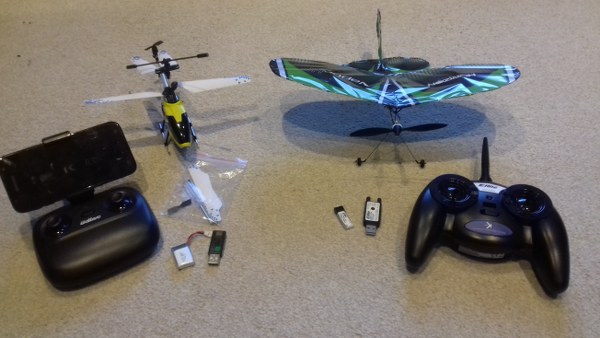
On the left is a UDI helicopter bought for £40. It weighs around 70grams with battery and flies for
4-5 minutes on a charge. Comes with transmitter, flight battery, charger - all you need to add is AA batteries
for the transmitter. Included is a real time video camera that can transmit via WiFi to your mobile phone
once the app is installed. You can even control it from your phone. Flying is a breeze with the auto take off
and auto land function and soon you'll be flying around the house, through doors and up the stairs.
On the right is a Horizon Hobby Vapor Lite at around £100. It weighs in at 13grams with battery and
3 channel radio. It comes with Spektrum compatible 4 channel DSMX transmitter, charger, flight battery -
like the helicopter all you need to add are the transmitter AA batteries. Yes it does bind and work with standard
Spektrum DSMX receivers, I tested myself! So far it taxis well but I'm leaving the first flight until the indoor
flying evening when there's more room.
OK, so that's ready to fly options.
But how about building your own RC model?
Kits are available and one very good example is this American site Stevens Aeromodel. Unfortunately it seems
he only sends orders over £135 to UK due to issues with VAT registration. However the site gives some idea of
what is available. Micro radio gear is available and receivers compatible with Spektrum, FRSky and Futaba are
fairly common.
4 Max have two interesting kits that include prop, motor and servos for £59.99! - just add micro receiver:
Beechcraft T34 Mentor Fokker E1 Eindecker
Receiver options available:
a) a combined receiver and typically 2 linear servos comes in at a couple of grams
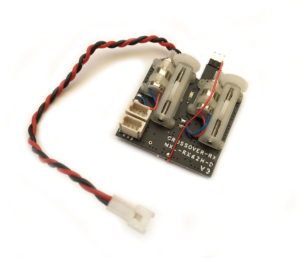 The
Spektrum AR6400 weighs 3.9 grams
The
Spektrum AR6400 weighs 3.9 grams b) some receivers come with integral ESC
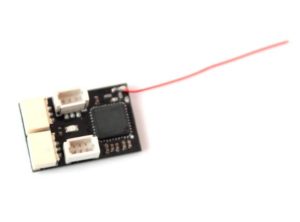 This
RX42-D is a 5 channel DSMx compatible receiver with
This
RX42-D is a 5 channel DSMx compatible receiver withintegral BRUSHED ESC. A version for brushless motors is also available.
Steve Webb models has a selection of micro receivers with prices ranging from £22.99 to £49.99 compatible
with either Futaba, Spektrum or FRSky.
c) the traditional separate receiver and servo option
The Radiolink R6DSM 10channel receiver weighs in at 1.5grams and has Sbus output so you'll need to find
suitable micro servos. Alternatively the R6DS 6 channel receiver weighs in at 3.4grams and has standard servo
output connectors. It operates with a 3 to 6V battery and offers 600mtrs range. The ability to operate using a
single cell LiPo is significant as some lightweight servos cannot handle voltages above 4.2V - more about this
later.
Futaba offer their R3206SBM 6 channel T-FHSS receiver weighing in at just 1gram! It has no servo plugs,
you will need to solder the servo leads onto the receiver - not a trivial task at this size!
There are also Futaba compatible micro receivers:
- Tarot RFASB 16 channel FASST compatible for SBUS - will need digital servos.
- Super Micro RX42E-S weighs 1.25grams, requires a 1S LiPo (3.3 to 4.2V) and has a 1S 5A brushless ESC.
Spektrum offer their SPM4650 weighing 1.4grams and has Sbus output so again you'll need to find suitable
micro servos. This receiver also has telemetry functions.
Again there are Spektrum compatible receivers:
- Super Micro RX42D weighing 1gram and like the Futaba version requires a 1S LiPo (3.3 to 4.2V) but has
a 1S 2.5A brushless ESC.
- OrangeRx R410X 4 channel receiver weighing 2.7grams and has standard servo output plugs. Power supply
is 3.6 to 9.6V however care is needed as micro servos typically need 3 to 4.2V maximum (ie 1S LiPo).
FRSky offer their Micro XM+ receiver weighing in at 1.6grams and has Sbus output so digital servos are
needed. Power supply is 3.7 to 10V, again care is needed as micro servos typically need 3 to 4.2V maximum
(ie 1S LiPo).
Now a look at servos. Receivers with built in servos are probably a good choice for many indoor aircraft.
However if you need independant servos then you'll need to decide on your receiver first, then select the
appropriate servos depending on whether your receiver has standard servo outputs or has an Sbus output.
Digital servos seem to start at 1.7grams like the AFRC nano servo which I could only find on Ebay.
Priced at £7.40 it seemed reasonable but it comes from China so may take time to deliver. Also I could not
find any technical detail - does it work with standard servo outputs, is it compatible with all types of Sbus and
how do you actually program it to respond to a selected Sbus channel (aileron, elevator etc etc).
With my standard size Futaba digital servos, they worked fine with analog but to get them to respond
correctly using Sbus I had to buy a programmer (which incidently wasn't clear at purchase).
The working voltage for this servo is stated as 3.7 to 5.0V however other sites suggest it should not be used
above 4.2V.
Steve Webb's "servoshop" sells the Super-Micro 1.7gram micro digital servo that can only be used on a 1S LiPo
(or suitable alternative to a maximum of 4.2V). It seems to be similar to the AFRC nano above but I can't be
sure. Also I couldn't find answers to those technical questions - the specifications page was very light on
useful compatibility data and I wasn't sure if it actually worked with standard servo outputs.
Batteries:
Many indoor aircraft operate using 1S LiPos and there are plenty of options from sub 40mAHr to hundreds of
mAhr - choosing one is really down to what weight your chosen model can handle.
There are many formats - here are a few:
a) one with built in JST PH 2.0mm plug - this is quite inconvenient and tends to be more expensive and harder
to find - if you are building your own model then I'd avoid these
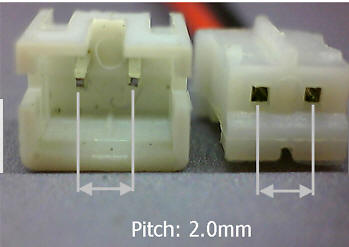

b) a common connector type used on 1S batteries is the JST XH2.54 and many 1S chargers come with this
connector. Note the connector style carefully - it has small locating tabs on either side to avoid getting the
polarity wrong. To connect to your receiver you may need to make up an adaptor lead.
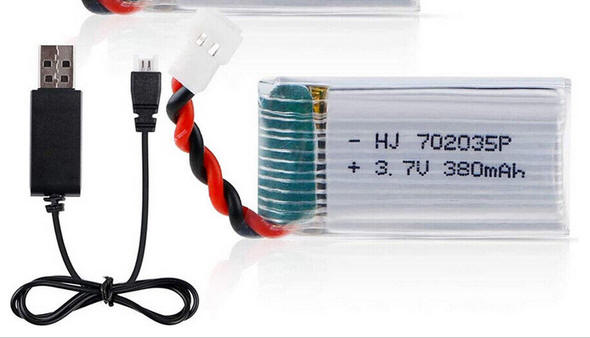
c) you may also find suitable batteries with connectors for your receiver. This is the best option though you
may need to make up an adaptor lead for the 1S charger.
Concluding:
By far the easiest starting point is to purchase a ready to fly model. If you are unfamiliar with indoor flying and
lightweight aircraft then it's a good introduction.
Building from a kit and deciding on radiogear, motors, gearboxes etc for lightweight models can be time
consuming and deciding on your RC gear isn't straight forward. Lightweight servos in particular are not easy to
decide on, receivers with built in servos seem simpler and lighter and certainly for models up to 30grams or so
they seem to be the better option - less weight due to minimal if no casing etc.
Care is needed to when using separate receivers and servos - check supply voltages carefully and make sure
they really operate well on 1S LiPo's. Also check digital servo compatibility if you are using Sbus.
Building your indoor model using 1S LiPo's gives plenty of equipment choices and is a good starting point.
I haven't investigated indoor models using 2S upwards cells.
Lastly some useful links:
paper aircraft ideas:
https://www.foldnfly.com/#/1-1-1-1-1-1-1-1-2
mini RC helicopters:
https://www.1001hobbies.co.uk/18298-rc-helicopters
mini RC planes:
https://www.elitemodelsonline.co.uk/Aircraft/Indoor-and-Micro
build your own:
https://www.amaflightschool.org/diy/how-build-indoor-catapult-launch-glider-science-olympiad
introduction and ideas:
https://www.rc-airplane-world.com/indoor-rc-airplanes.html
Good Luck!